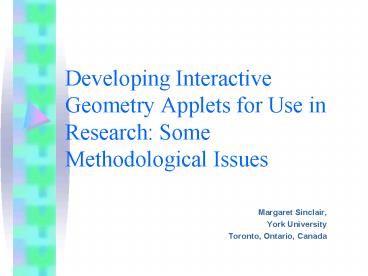Developing Interactive Geometry Applets for Use in Research: Some Methodological Issues - PowerPoint PPT Presentation
1 / 18
Title:
Developing Interactive Geometry Applets for Use in Research: Some Methodological Issues
Description:
Developing Interactive Geometry Applets for Use in Research: Some Methodological ... Task design - central yet usually part of development ... and crucially, ... – PowerPoint PPT presentation
Number of Views:35
Avg rating:3.0/5.0
Title: Developing Interactive Geometry Applets for Use in Research: Some Methodological Issues
1
Developing Interactive Geometry Applets for Use
in Research Some Methodological Issues
- Margaret Sinclair,
- York University
- Toronto, Ontario, Canada
2
Design research
- Task design - central yet usually part of
development rather than the focus of research. - Research on task design needed
- to clarify what is arbitrary and what is
essential about tasks - to allow replication of task-based research
results, and to inform the development of systems
of tasks. - (Sierpinska, 2004)
3
Research methods
- Observations, interviews, surveys, tests
- For Design research
- Iterative process of design, test and refine in
light of - pedagogical design principles
- Content and process
- interface design principles
- user feedback.
4
Design and the user
- For any design to be successful, in terms of
developing usable and understandable products,
then that design must be based on the needs and
interests of the users and be informed by an
understanding of their limitations and
capabilities. - Norman, D. (1998). The psychology of everyday
things. New York, NY Basic Books
5
Research methodology
- Includes consideration of
- the researchers beliefs, attitudes and values,
- the research questions being explored,
- the answers being sought,
- and crucially,
- the nature of the key informants together with
their social and cultural environments. - (Goodchild, S., English, L. (Eds.). (2002).
Researching mathematics classrooms A critical
examination of methodology. Westport, CT
Greenwood Publishing p. xii)
6
The study
- 2 classes of grade 7 students
- Students worked in pairs in a lab
- Math content transformations
- Task materials JavaSketches and worksheets
- Task reviewers the 2 teachers and 3 math
education students.
7
The two reflection tasks
- Reflection concepts
- Wheres the mirror?
8
Reviewer feedback
- Comments mostly favourable
- Numerous small errors reported
- Specific problems size of screen, use of
prime notation, use of conjecture - After modifications and corrections reviewers
confident students would not have problems with
content/terminology/use of applets.
9
Observations
- Students were enthusiastic participants, actively
involved in working with the sketches, discussing
what they noticed and writing responses to
questions - but .
10
Findings design problems
- Some students -
- didnt notice buttons, segments, or angles, or
missed particular questions and prompts - in, Reflection Concepts, had difficulty figuring
out which segment or angle was being controlled - didnt interpret questions as expected problem
vague wording.
11
Other findings
- Students tentative needed encouragement and
help - Difficulty with
- Math terms - parallel, perpendicular
- Terms with double meanings coincide, always
- Naming angles and segments
- Line of symmetry vs mirror no transfer of
properties - Poor explanations.
12
Examining the difficulties
- Some could only be discovered by having students
engage with the tasks - technical glitches
- the extent of students tentative behaviour
- difficulty with always.
- Many could have been predicted
- line of symmetry rather than mirror
- difficulty with naming objects
- insufficient prior content knowledge
- lack of experience giving written explanations
and/or doing investigations.
13
What did we know about the students?
- Had covered background topics in previous grades
- Average to above average ability
- Used computers frequently but not for math.
- According to reviewers Students should have no
trouble with content/terms/use of applets.
14
What did we know about the reviewers?
- Relative newcomers to technology in mathematics
- Teachers
- not math specialists, but did teach math
- had taught these students since Sept. (Study was
in March) - Other reviewers math specialists at end of
teacher training for grades 6-10.
15
Questions
- Did the tasks appear deceptively straightforward?
- Did reviewers lack sufficient background/experienc
e to critically examine the tasks?
16
Questions
- Were reviewers reluctant to critique finished
objects? - Is there added difficulty in predicting student
behaviour in a technological environment?
17
Methodology revisited
- In design research we need to gather information
about the tasks in relation to the users. - During the testing the students are key
informants. - Before the testing the reviewers are key
informants.
18
Conclusion
- A designer requires first-hand knowledge of
reviewers and testers attitudes, approaches to
mathematics, prior content knowledge, and level
of technological skill, in order to make informed
decisions.































